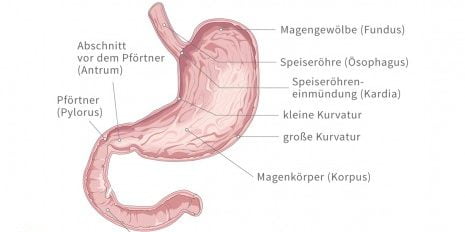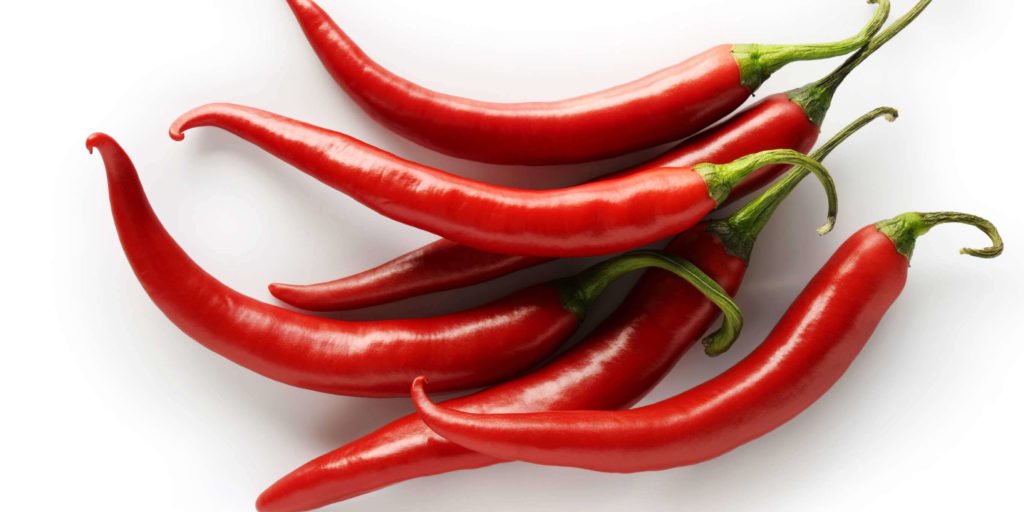The stomach, an amazing organ!
Between the oesophagus and duodenum
The stomach (gaster) is located in the left upper abdomen directly under the diaphragm. It connects the oesophagus (gullet) with the duodenum (duodenum) and performs numerous important functions for digestion. It is primarily used to store and break down food before it is passed on to the intestine for digestion. The stomach is a curved tube of muscle tissue. At the top, the mouth of the stomach or cardia (cardia ventriculi) forms the entrance to the stomach.
The body of the stomach forms the main part of the stomach
The base of the stomach or the gastric vault (fundus) arches directly above the mouth of the stomach. This section usually contains a large air bubble that is formed by swallowed air. Finally, the body of the stomach (corpus ventriculi) forms the main part of the stomach. It extends to the pyloric section. This in turn is subdivided into the entrance segment (antrum pyloricum), the pyloric channel up to three centimetres wide, which is responsible for transporting the pre-digested food into the duodenum, and the pylorus, the ring-shaped sphincter muscle.

The gastric juice
Once the food has reached the stomach, gastric juice is released, which is produced in the gastric mucosa. The amount depends on the composition of the food. Spicy food, alcohol, nicotine and caffeine, for example, promote greater secretion. Gastric juice contains various important components. Digestive enzymes; pepsinogen or pepsin for the digestion of proteins and lipases for the digestion of fats. Hydrochloric acid; it converts the inactive precursor pepsinogen into the active pepsin and provides the acidic environment that pepsin needs for its work and kills bacteria.
A brief digression – stomach, liver and gall bladder
They are involved in our digestion: gastric juice and bile. Gastric juice is produced in many small glands in the stomach lining, around three to four litres per day. It contains hydrochloric acid and digestive enzymes and other substances that are important for the absorption of nutrients. The hydrochloric acid breaks down food and also kills bacteria. The digestive enzymes break down proteins from the food. The liver, one of the largest organs in our body, is the central metabolic organ and fulfils various vital functions in our body. For example, the liver converts the protein ingested with food into the body’s own protein. It forms the starting products for the production of our sex hormones and endogenous fats. It produces blood clotting factors, breaks down old blood cells and stores iron. The liver is also involved in the regulation of blood sugar levels and blood lipids. Its best-known function is probably to detoxify the body; it metabolises and breaks down harmful substances, alcohol, medication and the body’s own substances in order to render them harmless. Our liver also produces up to one litre of bile per day, which is passed on to the gallbladder. The gallbladder is located in a small indentation directly below the liver, to which it is connected via the bile duct. The gallbladder serves as a buffer for bile, a viscous yellow-green fluid that is necessary for the digestion of fats. This is released into the duodenum via the bile duct as required.
Hydrochloric acid in our stomach!
Considering that hydrochloric acid is a very strong acid, it is surprising that the stomach does not digest itself, so to speak! This is due to a thick layer of mucus, which protects the stomach wall from the aggressive hydrochloric acid and is also formed by the stomach lining. How long the chyme remains in the stomach depends on the composition of the food. Easily digestible foods, such as fruit and vegetables, only remain in the stomach for around 1-2 hours, whereas fatty foods that are difficult to digest remain there for around 5-8 hours. The undulating, powerful muscle movements of the stomach (gastric peristalsis) help to break down the food and constantly mix the food with the gastric juice until the semi-digested chyme is formed. You can also feel this process from time to time when your stomach makes itself heard with a gurgle, rumbling or growling.
The chyme is finally transported through the pylorus into the duodenum in batches.
What can “upset your stomach”?
Certain idiomatic expressions indicate that the stomach not only an organ in the body, but also plays a major role in the psyche Also plays a major role in the psyche. Mental strain and negative stress (distress) can certainly lead to stomach complaints. This is because the vegetative Nervous system has a close connection with the digestive system. But also certain foods, such as raw vegetables, flatulent foods, coffee, fatty or sweet foods and sweeteners Food and sweeteners can also lead to various stomach problems. Some some people react more sensitively to certain foods than others. Here too here, too, there are phrases that remind us: “Having a good stomach” or “having a sensitive stomach”.
When the stomach causes problems
Stomach problems can manifest themselves in many different ways. These include pain, bloating, a feeling of fullness and pressure and nausea. Or do you know the expression “that makes me sick”? Heartburn (reflux) can also be a nuisance. It is normal to suffer from such symptoms from time to time, but if they occur more frequently, you should take a closer look. Is it due to certain foods or are you suffering from more serious problems? Please consult a doctor if you have more serious and longer-lasting stomach problems. Below we take a brief look at two common stomach problems.

Heartburn (reflux)
Heartburn, reflux, acid reflux, burning stomach – different names for the same ailment. Stomach acid flows back into the oesophagus or, in extreme cases, even into the mouth, causing a burning sensation. If this happens to an abnormal extent, it is referred to as “gastro-oesophageal reflux disease”. The aggressive gastric juice can cause damage to the oesophageal wall. This inflammation is visible as a superficial injury to the mucous membrane and resembles an abrasion. This is referred to as “reflux oesophagitis”. Fatty foods in particular, but also alcohol and coffee, can have a very strong effect on people who already suffer from heartburn.
Inflammation of the stomach lining (gastritis)
Gastritis can be acute or chronic. Here we will only deal with acute gastritis. The protective gastric mucous layer can be damaged by various influences, causing stomach acid to penetrate to the underlying stomach wall, resulting in painful inflammation. Possible causes of acute gastritis include food poisoning, infections with bacteria, viruses or fungi, heavy nicotine, alcohol or caffeine consumption, severe psychological stress and regular use of painkillers such as non-steroidal anti-inflammatory drugs. The latter is a widespread problem! For this reason, proton pump blockers (so-called gastric acid blockers) are usually prescribed prophylactically when antirheumatic drugs are administered. However, these in turn have a not inconsiderably long list of side effects!
How do you ensure a healthy stomach?
As already mentioned, not everyone’s stomach is equally sensitive to the same foods. But for most people, fatty or sweet foods, alcohol and coffee are most likely to cause stomach problems. Not everyone tolerates many types of cabbage and onions well either. On the other hand, ginger is known to be extremely stomach-friendly and can even help against nausea. Fennel, caraway and aniseed (also as tea) aid digestion. Cinnamon is anti-inflammatory, as is turmeric, which also has an antispasmodic effect and inhibits the growth of bacteria, viruses, parasites and fungi! And as paradoxical as it may sound, chilli can be used to protect the stomach! It used to be assumed that spicy food was harmful to the stomach. But the protection of the stomach lining provided by chilli is so striking that it can be used to treat stomach burns and reflux, for example. The capsaicin contained in chilli stimulates the production of mucus in the stomach lining. The protective mucus layer becomes thicker and the stomach is better protected from stomach acid. Cayenne pepper consists of ground chilli peppers. There are over 400 varieties of chilli, which originate from South America and vary greatly in their degree of heat.

Stress reduction
It is also recommended to eat several small meals a day. The stomach can cope better with this than with two or three large portions. It is also important to take enough time to eat, concentrate on it and chew sufficiently. A beautifully prepared meal can work wonders – after all, as the saying goes, “you eat with your eyes”! Eating should be a pleasure, not a source of stress!
Stress reduction is another keyword in connection with a healthy stomach. This is usually not easy, but it is not only your stomach that will thank you for a balanced life with enough joyful breaks!
We wish you and your stomach good health and hope that our information has served you well!

